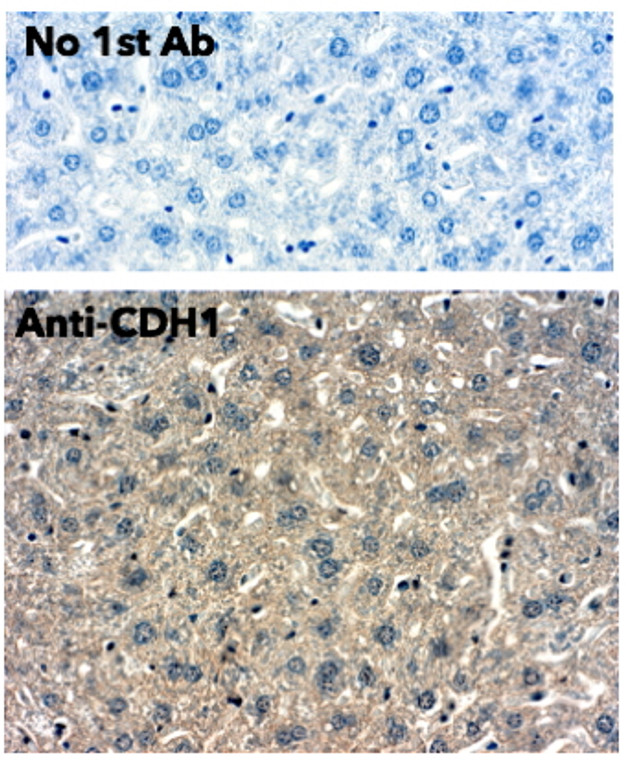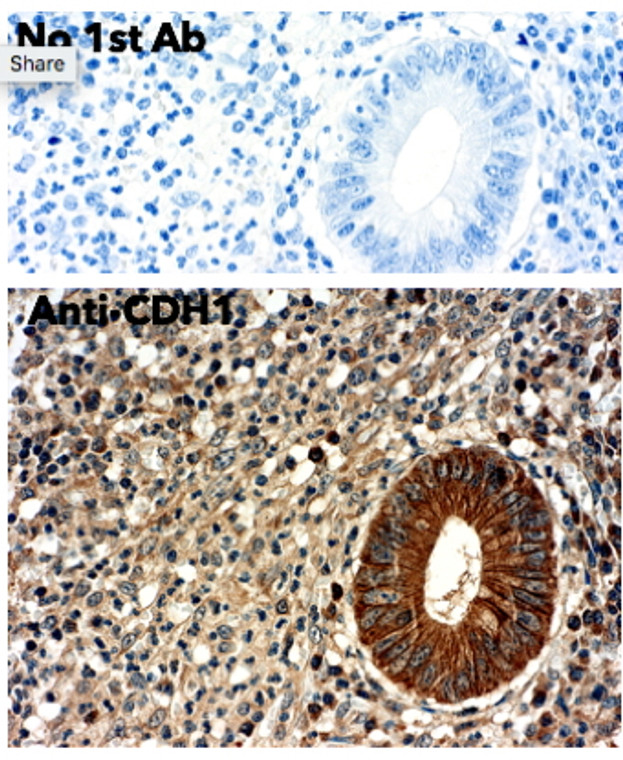| Host: |
Goat |
| Applications: |
WB/IHC-F/IHC-P |
| Reactivity: |
Human/Rat/Mouse/Monkey/Canine |
| Note: |
STRICTLY FOR FURTHER SCIENTIFIC RESEARCH USE ONLY (RUO). MUST NOT TO BE USED IN DIAGNOSTIC OR THERAPEUTIC APPLICATIONS. |
| Short Description: |
Goat polyclonal antibody anti-E-Cadherin (750 to 850) is suitable for use in Western Blot, Immunohistochemistry and Immunohistochemistry research applications. |
| Clonality: |
Polyclonal |
| Conjugation: |
Unconjugated |
| Isotype: |
IgG |
| Formulation: |
PBS, 20% Glycerol and 0.05% Sodium Azide. |
| Purification: |
This antibody is epitope-affinity purified from goat antiserum. |
| Concentration: |
2 mg/ml |
| Dilution Range: |
WB 1:500-1:2000IHC-F 1:250-1:1:000IHC-P 1:250-1:1:000 |
| Storage Instruction: |
For continuous use, store at 2-8 C for one-two days. For extended storage, store in-20 C freezer. Working dilution samples should be discarded if not used within 12 hours. |
| Gene Symbol: |
CDH1 |
| Gene ID: |
999 |
| Uniprot ID: |
CADH1_HUMAN |
| Immunogen Region: |
750 to 850 |
| Accession Number: |
ENSG00000039068 |
| Specificity: |
Detects endogenous levels of total E-cadherin protein by Western blot in the whole cell lysates (COS-7 and MDCK). |
| Immunogen: |
Purified recombinant peptide derived from within residues 750 to 850 of human CDH1 produced in E. coli. |
| Tissue Specificity | Non-neural epithelial tissues. |
| Post Translational Modifications | During apoptosis or with calcium influx, cleaved by a membrane-bound metalloproteinase (ADAM10), PS1/gamma-secretase and caspase-3. Processing by the metalloproteinase, induced by calcium influx, causes disruption of cell-cell adhesion and the subsequent release of beta-catenin into the cytoplasm. The residual membrane-tethered cleavage product is rapidly degraded via an intracellular proteolytic pathway. Cleavage by caspase-3 releases the cytoplasmic tail resulting in disintegration of the actin microfilament system. The gamma-secretase-mediated cleavage promotes disassembly of adherens junctions. During development of the cochlear organ of Corti, cleavage by ADAM10 at adherens junctions promotes pillar cell separation. N-glycosylation at Asn-637 is essential for expression, folding and trafficking. Addition of bisecting N-acetylglucosamine by MGAT3 modulates its cell membrane location. Ubiquitinated by a SCF complex containing SKP2, which requires prior phosphorylation by CK1/CSNK1A1. Ubiquitinated by CBLL1/HAKAI, requires prior phosphorylation at Tyr-754. O-glycosylated. O-manosylated by TMTC1, TMTC2, TMTC3 or TMTC4. Thr-285 and Thr-509 are O-mannosylated by TMTC2 or TMTC4 but not TMTC1 or TMTC3. (Microbial infection) Cleaved by S.pyogenes SpeB protease.leading to its degradation. Degradation by SpeB promotes bacterial translocation across the host epithelial barrier. |
| Function | Cadherins are calcium-dependent cell adhesion proteins. They preferentially interact with themselves in a homophilic manner in connecting cells.cadherins may thus contribute to the sorting of heterogeneous cell types. CDH1 is involved in mechanisms regulating cell-cell adhesions, mobility and proliferation of epithelial cells. Has a potent invasive suppressor role. It is a ligand for integrin alpha-E/beta-7. E-Cad/CTF2 promotes non-amyloidogenic degradation of Abeta precursors. Has a strong inhibitory effect on APP C99 and C83 production. (Microbial infection) Serves as a receptor for Listeria monocytogenes.internalin A (InlA) binds to this protein and promotes uptake of the bacteria. |
| Protein Name | Cadherin-1Cam 120/80Epithelial CadherinE-CadherinUvomorulinCd Antigen Cd324 Cleaved Into - E-Cad/Ctf1 - E-Cad/Ctf2 - E-Cad/Ctf3 |
| Database Links | Reactome: R-HSA-1474228Reactome: R-HSA-198933Reactome: R-HSA-216083Reactome: R-HSA-351906Reactome: R-HSA-418990Reactome: R-HSA-5626467Reactome: R-HSA-8876493Reactome: R-HSA-9823730 |
| Cellular Localisation | Cell JunctionAdherens JunctionCell MembraneSingle-Pass Type I Membrane ProteinEndosomeGolgi ApparatusTrans-Golgi NetworkColocalizes With Dlgap5 At Sites Of Cell-Cell Contact In Intestinal Epithelial CellsAnchored To Actin Microfilaments Through Association With Alpha-Beta- And Gamma-CateninSequential Proteolysis Induced By Apoptosis Or Calcium InfluxResults In Translocation From Sites Of Cell-Cell Contact To The CytoplasmColocalizes With Rab11a Endosomes During Its Transport From The Golgi Apparatus To The Plasma Membrane |
| Alternative Antibody Names | Anti-Cadherin-1 antibodyAnti-Cam 120/80 antibodyAnti-Epithelial Cadherin antibodyAnti-E-Cadherin antibodyAnti-Uvomorulin antibodyAnti-Cd Antigen Cd324 Cleaved Into - E-Cad/Ctf1 - E-Cad/Ctf2 - E-Cad/Ctf3 antibodyAnti-CDH1 antibodyAnti-CDHE antibodyAnti-UVO antibody |
Information sourced from Uniprot.org
12 months for antibodies. 6 months for ELISA Kits. Please see website T&Cs for further guidance











